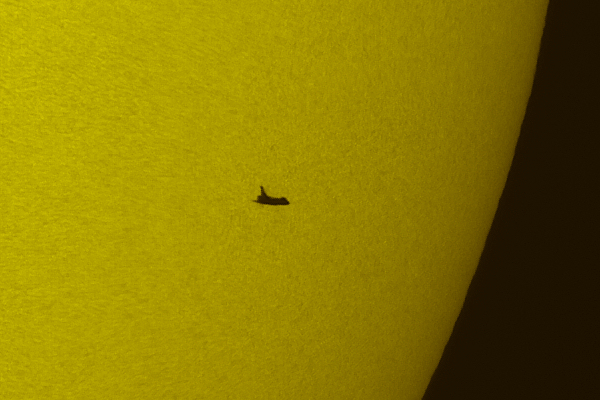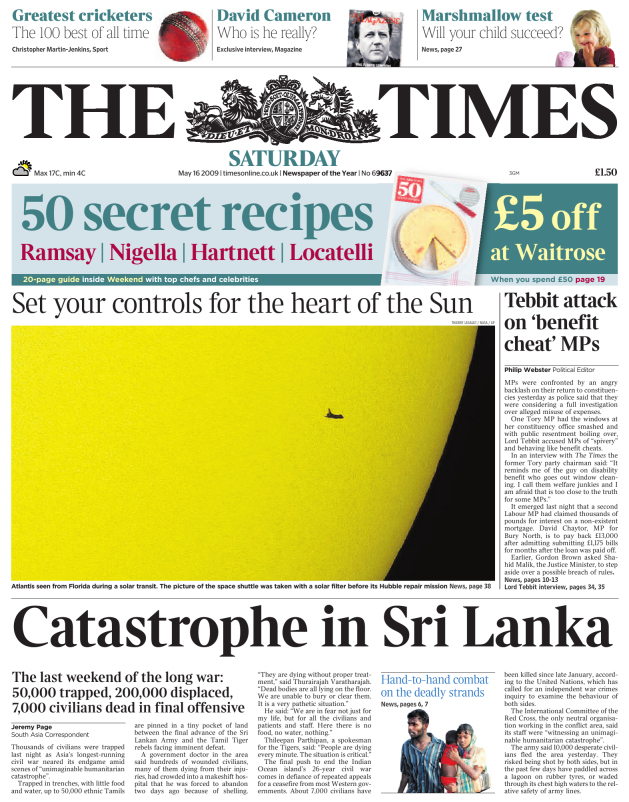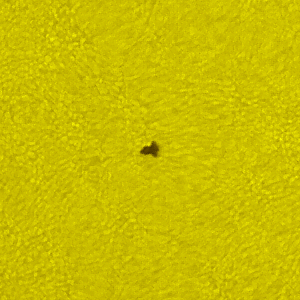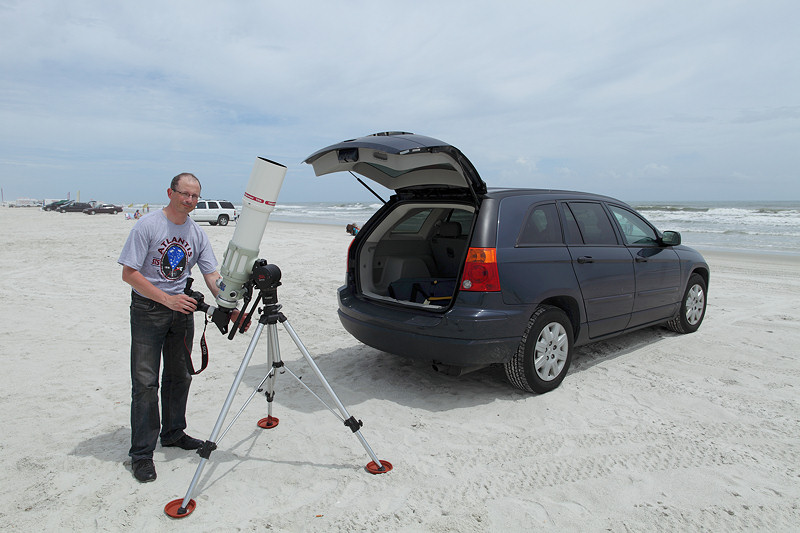
SOLAR TRANSIT OF ATLANTIS AND THE HUBBLE SPACE TELESCOPE
|
Any use of one of these images other than strictly private must be subject to prior authorization from legault@astrophoto.fr The following transit has been taken from the vicinity of the Kennedy Space Center on May 12th, only 24 hours after the launch of Atlantis as it was halfway to Hubble, at a distance of only 260 km. Duration of the transit: only 0.3 second. The thin silhouette confirms that the cargo bay doors were opened. Takahashi TOA-130 refractor (diameter 130mm, final focal 2200mm or 3400mm) on Manfrotto video tripod, Baader solar prism and Canon 5D mark II, plus a detailed map of Florida, a GPS (for the precise location) and a radio-controlled watch (for the precise time). Exposure of 1/8000s at 100 ISO (RAW). The ships being too small and too fast to be watched through the viewfinder, a "blind" series of 16 images (at a pace of 4 images/s) starts 2 seconds before the predicted time. |

| These images have been published in numerous newspapers, especially in Chile (El Mercurio), Brazil, Canada (Toronto Star), USA (Chicago Tribune)...including the front page of The Times (UK) of May 16th: |

|
Only image ever taken of a transit of a space shuttle (Atlantis) and the Hubble Space Telescope (HST) in front of the Sun, during the last repair mission of Hubble, obtained from Florida at 100 km south of the Kennedy Space Center on May 13th 2009 12:17 local time, several minutes before grapple of Hubble by Atlantis. Transit duration: 0.8s. Transit
bandwidth on Earth: 5.6 km. Altitude: 600 km. Speed: 7 km/s (25000 km/h).
Length of Atlantis :
35m, length of Hubble : 13m. |
| The following transit has been taken from the Kennedy Space Center on May 18th, during the last Hubble repair extra-vehicular walkout. We are looking at the top of Atlantis and Hubble, with the angle to Atlantis coming from a little towards the tail. |

| Waiting one of the transits from the Kennedy Space Center, near the pad 39B where the rescue shuttle Endeavour is awaiting in case Atlantis could not come back to Earth: |

| Waiting one of the transits from Daytona Beach Shores, Florida: |

|
Yes, sometimes there are clouds in Florida, especially during this STS-125 mission in which I had, for some transits, to run after gaps of blue sky and sometimes suffer from violent thunderstorm rainfalls and a lot of atmospheric turbulence that made fuzzy most of the images taken, except the ones presented above. Here are answers to the most frequent questions: - how is it possible that the space ships and the Sun are sharp simultaneously on the images, although they are at very different distances? Beyond several kilometers, a telescope does not show a difference of focus, all objects seem to be at infinity whatever their distance: 600 km (Atlantis and Hubble), 150 millions km (the Sun) or a galaxy at billions light-years. In other words, the photographic notion of "depth of field" does not exist in astronomy. - why do the sheeps seem so big compared to the Sun? The Sun is 250000 times farther than Hubble and therefore appears 250000 times too small in comparison. If Hubble was placed at the distance of the Sun, it would occupy in the photographs about 1/50000 of a pixel and would be of course invisible. The Sun could contain one million of small, very small planets like the Earth... - why is the surface of the Sun not smooth on the photographs? The structure visible on the photographs is not noise, it is the solar granulation. Each grain is a bubbling cell of solar gas that has approximately the size of Texas. On each image, some areas seem to have less granulation than others, it is caused by the atmospheric turbulence that blurs these areas. - why don't we see sunspots or prominences (flares) on the Sun? The Sun goes through a period of calm and does not currently shows spots. The prominences are visible only with a special narrow-band filter (Hydrogen-alpha), the filters being used here are broad-band and cannot show them. - is is the true color of the Sun? The Sun emits a white-yellow light. But to observe and to photograph it, one must use very powerful solar filters that can transmit different colors; some filters give a bluish color, other a white color, others an orangey color. Most astronomers choose a yellow-orange tint for their images of the Sun; www.spaceweather.com shows the daily Sun under an orangey color. - why is the edge of the Sun darker than its center? This darkening at the edge is a physical effect due to the fact that the Sun is not a solid object but a sphere of gas whose surface transmits and diffuses the light emitted by its core. - how can Atlantis cast on shadow on the surface of the Sun? It not a shadow but a silhouette. |